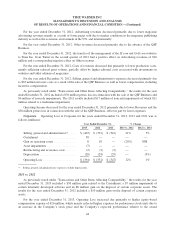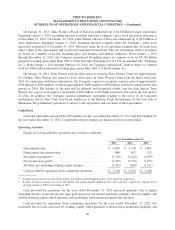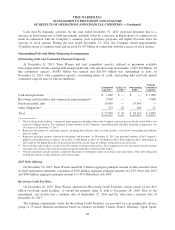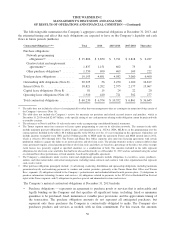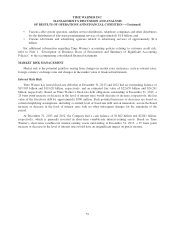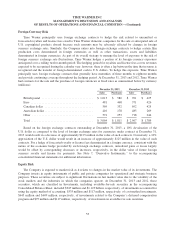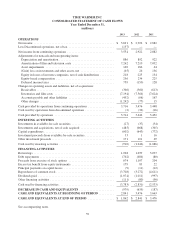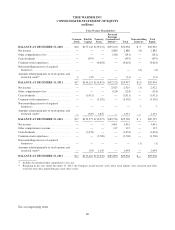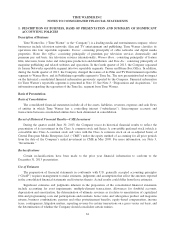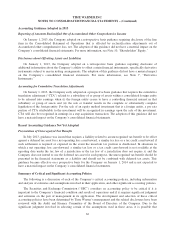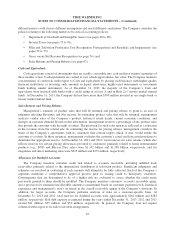Time Magazine 2013 Annual Report Download - page 69
Download and view the complete annual report
Please find page 69 of the 2013 Time Magazine annual report below. You can navigate through the pages in the report by either clicking on the pages listed below, or by using the keyword search tool below to find specific information within the annual report.
TIME WARNER INC.
MANAGEMENT’S DISCUSSION AND ANALYSIS
OF RESULTS OF OPERATIONS AND FINANCIAL CONDITION – (Continued)
Foreign Currency Risk
Time Warner principally uses foreign exchange contracts to hedge the risk related to unremitted or
forecasted royalties and license fees owed to Time Warner domestic companies for the sale or anticipated sale of
U.S. copyrighted products abroad because such amounts may be adversely affected by changes in foreign
currency exchange rates. Similarly, the Company enters into foreign exchange contracts to hedge certain film
production costs denominated in foreign currencies as well as other transactions, assets and liabilities
denominated in foreign currencies. As part of its overall strategy to manage the level of exposure to the risk of
foreign currency exchange rate fluctuations, Time Warner hedges a portion of its foreign currency exposures
anticipated over a rolling twelve-month period. The hedging period for royalties and license fees covers revenues
expected to be recognized during the calendar year; however, there is often a lag between the time that revenue is
recognized and the transfer of foreign-denominated cash to U.S. dollars. To hedge this exposure, Time Warner
principally uses foreign exchange contracts that generally have maturities of three months to eighteen months
and provide continuing coverage throughout the hedging period. At December 31, 2013 and 2012, Time Warner
had contracts for the sale and the purchase of foreign currencies at fixed rates as summarized below by currency
(millions):
December 31, 2013 December 31, 2012
Sales Purchases Sales Purchases
British pound .................................. $ 1,013 $ 580 $ 701 $ 425
Euro ......................................... 481 468 371 426
Canadian dollar ................................ 569 332 692 425
Australian dollar ................................ 410 178 485 269
Other ........................................ 591 253 718 244
Total ......................................... $ 3,064 $ 1,811 $ 2,967 $ 1,789
Based on the foreign exchange contracts outstanding at December 31, 2013, a 10% devaluation of the
U.S. dollar as compared to the level of foreign exchange rates for currencies under contract at December 31,
2013 would result in a decrease of approximately $125 million in the value of such contracts. Conversely, a 10%
appreciation of the U.S. dollar would result in an increase of approximately $125 million in the value of such
contracts. For a hedge of forecasted royalty or license fees denominated in a foreign currency, consistent with the
nature of the economic hedge provided by such foreign exchange contracts, unrealized gains or losses largely
would be offset by corresponding decreases or increases, respectively, in the dollar value of future foreign
currency royalty and license fee payments. See Note 7, “Derivative Instruments,” to the accompanying
consolidated financial statements for additional information.
Equity Risk
The Company is exposed to market risk as it relates to changes in the market value of its investments. The
Company invests in equity instruments of public and private companies for operational and strategic business
purposes. These securities are subject to significant fluctuations in fair market value due to the volatility of the
stock markets and the industries in which the companies operate. At December 31, 2013 and 2012, these
securities, which are classified in Investments, including available-for-sale securities in the accompanying
Consolidated Balance Sheet, included $947 million and $1.123 billion, respectively, of investments accounted for
using the equity method of accounting, $335 million and $117 million, respectively, of cost-method investments,
$645 million and $609 million, respectively, of investments related to the Company’s deferred compensation
program and $97 million and $117 million, respectively, of investments in available-for-sale securities.
53



